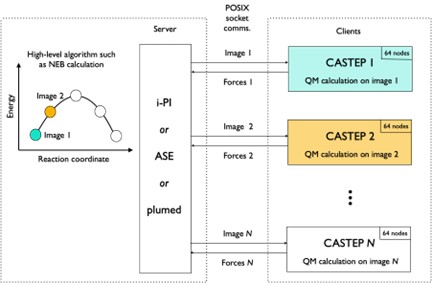Support for advanced transition state search techniques in CASTEP
ARCHER2-eCSE02-04
PI: Dr James R Kermode (University of Warwick)
Co-I(s): Prof. Paul Hodgkinson (University of Durham), Dr Peter Byrne (University of York), Dr Phil Hasnip (University of York), Prof Matt Probert (University of York)
Technical staff: Dr Simone Sturniolo (Science and Technology Facilities Council)
Subject Area:

Overview Figure: Schematic of client/server configuration. Each image runs within an MPI CASTEP run, linked by the i-PI socket protocol. The same schematic applies to the decomposition of the loosely coupled ensemble problem within a single MPI application.
Density functional theory (DFT) is a quantum mechanical simulation method that has become one of the most widely used research tools, with approximately 30,000 papers using it published each year. The CASTEP DFT code is a UK flagship code, specialised for solid materials, and is heavily used on ARCHER (300-400 active users). While support for obtaining the ground-state electronic and atomic configurations is now very good, computing transition states, reaction rates, and exploring free energy barriers with enhanced sampling were all still poorly supported in the CASTEP code before this eCSE was completed, despite their importance for a wide range of chemistry and materials science applications.
In this eCSE project we have implemented two key new features in the CASTEP code to address these issues: (i) support for the extremely widely used (>12k citations) nudged elastic band (NEB) transition state search tool, augmented by a state-of-the-art robust optimizer; (ii) an interface to the i-PI universal force engine which allows CASTEP to be connected efficiently to a wide range of external codes with enhanced sampling capabilities.
The new NEB implementation has also been parallelised so that it can be used efficiently on massively parallel computing centres, such as ARCHER2. We used a farm-based MPI parallelization approach where each image along the chain of states representing the reaction path runs on its own set of cores. The farms are loosely coupled, since they only need to exchange information at the end of each electronic minimisation. This leads to perfect weak scaling, validated on a 16-image system with up to 16 farms respectively.
Our new code has been merged into the CASTEP development repository and will be included in the forthcoming 2022 release of the code, after which it will be widely available to ARCHER users. Key beneficients of the project include the CCP-NC, CCP9 and UKCP communities, where the new tools will aid in reconciling experimental observations with atomic-scale behaviour, helping to guide and interpret future experiments.
Information about the code
The new functionality was included in the 2022 release of CASTEP. ARCHER2 users can find information on using CASTEP via the ARCHER2 webpage.
